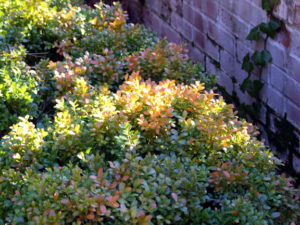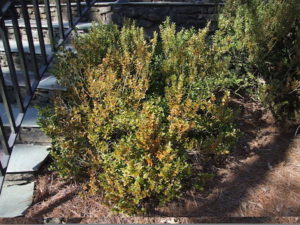 Boxwood bronzing (the foliage color becomes orange, yellowish, or reddish-brown) in winter time is usually considered to be associated with exposure to the winter sun, frequent frost, and wind. Exposed roots, dry soil or wet soil can also contribute to the phenomenon.
Boxwood bronzing (the foliage color becomes orange, yellowish, or reddish-brown) in winter time is usually considered to be associated with exposure to the winter sun, frequent frost, and wind. Exposed roots, dry soil or wet soil can also contribute to the phenomenon.
In some cases bronzing can be reduced or avoided by planting in a shaded site protected from harsh winter winds. Bronzing can also be caused by nematode infestations, which are not treatable at this time.
In almost all cases, when only some of the boxwoods in a planting are showing the bronzing, the root system, crown or basal stem of those plants are damaged and not functioning correctly and the plant is declining.
One of the major cause of boxwood decline is the buildup of debris in the crown area. Aerial roots begin to grow into the rotted leaf debris. Aerial roots function poorly and are very susceptible to freezing and dessication. As these roots deteriorate the stems are detrimentally affected and this leads to the decline. Keeping the crown of the boxwoods clear of debris will go a long way towards maintaining a healthy boxwood. 
Usually the bronzing slowly disappears once the weather begins to warm in the spring but the underlying problem still remains.
« Back to Glossary Index